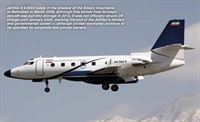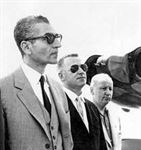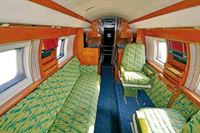Фотографии
-
The Islamic Republic of Iran Air Force’s last operational JetStar, serial 5-9003, on finals into Mehrabad in March 2009. The IRIAF operated a total of four examples of the type in three variants. This aircraft, initially an Iraqi Airways machine, was appropriated by the IRIAF after having been flown to Iran to avoid the Gulf War in 1991.
Самолёты на фотографии: Lockheed C-140 JetStar - США - 1957
-
Регистрационный номер: CF-DTF The Canadian government was one of the first non-corporate operators of the JetStar 6, two being acquired by the Department of Transport in early 1962. Seen here at a Canadian airport in October 1966 is the second to be delivered, CF-DTF (c/n 5088), in a colour scheme that emphasises the type’s rather purposeful lines.
Самолёты на фотографии: Lockheed C-140 JetStar - США - 1957
-
Регистрационный номер: EP-VRP [2] Unlike its identically registered predecessor, the second EP-VRP, JetStar 8 c/n 5137, was painted in a very austere overall dark gunship-grey scheme which robbed the aircraft of a great deal of its natural elegance. It is seen here taxying at Paris-Orly sometime during the early 1970s. The type’s distinctive 565 US gal (2,140lit) wing-mounted slipper tanks were initially trialled on the second prototype and fitted to all production JetStar 6s and 8s.
Самолёты на фотографии: Lockheed C-140 JetStar - США - 1957
-
Delivered in 1976 as EP-VLP, JetStar II c/n 5203 sported the updated variant’s Garrett AiResearch TFE731-3 turbofan engines and revised non-removable auxiliary fuel tanks glove-mounted on the wings in place of the previous variants’ slipper tanks. Sadly, 5-9001 (as it became) was destroyed in a fatal accident on approach to Isfahan in January 1995, in which several high-ranking IRIAF officers were killed.
Самолёты на фотографии: Lockheed C-140 JetStar - США - 1957
-
Регистрационный номер: EP-VRP [2] The original EP-VRP (c/n 5002), acquired by the Shah of Iran in June 1963, is seen here in the summer of 1967 during a visit to Gatwick Airport in the UK.
Самолёты на фотографии: Lockheed C-140 JetStar - США - 1957
-
JetStar II 5-9003 lands in the shadow of the Alborz mountains at Mehrabad in March 2009. Although this former Iraqi Airways aircraft was put into storage in 2015, it was not officially struck off charge until January 2020, marking the end of the JetStar’s military and governmental career - although civilian examples continue to be operated by corporate and private owners.
Самолёты на фотографии: Lockheed C-140 JetStar - США - 1957
-
Регистрационный номер: N329J First photograph of the Lockheed CL-329 JetStar utility transport powered by two Bristol Orpheus turbojets. Performance with these engines has surpassed all estimates, and the JetStar may be offered to customers in this as well as the four-engine layout.
CL-329 first prototype N329J (c/n 1001) made its maiden flight from the Lockheed Air Terminal at Burbank, California, on September 4, 1957, fitted with two Bristol Orpheus turbojets and minus the wing-mounted slipper tanks that became such a distinctive feature of production aircraft. This example survives at the Museum of Flight in Everett, Washington, USA.Самолёты на фотографии: Lockheed C-140 JetStar - США - 1957
-
The Shah inspects a JetStar at the Lockheed factory at Marietta, Georgia, in 1962. He liked what he saw and ordered a single example to be fitted to a VIP spec.
Самолёты на фотографии: Lockheed C-140 JetStar - США - 1957
-
The interior of JetStar 8 c/n 5137 - originally the second EP-VRP and subsequently given the serial 5-9001 - was fitted with a wood-panelled VIP interior and could accommodate six passengers in two-tone green seats. The starboard panel of the forward cabin bulkhead incorporated an altimeter, clock and airspeed indicator.
Самолёты на фотографии: Lockheed C-140 JetStar - США - 1957
-
Behind the first row of two rear-facing seats were a bench and two more seats facing each other, as seen in this photograph looking aft. Beyond the bench and rearmost seat was a small galley, with the lavatory at the rear of the aircraft. Retired from service in 1993 after 24 years of service, 5-9001 remains in storage at Mehrabad.
Самолёты на фотографии: Lockheed C-140 JetStar - США - 1957
-
Sadly, 5-9001 was destroyed in a fatal accident on approach to Isfahan in January 1995, in which several high-ranking IRIAF officers were killed.
Самолёты на фотографии: Lockheed C-140 JetStar - США - 1957
Статьи
- -
- ??? - Mad dogs & englishmen
- A.Arthy - Two days in February (1)
- B.Taghvaee - The shah's Jetstars
- C.Gibson - Hawker's Star Destroyer
- F.Villeneuve - Hawk One (2)
- G.Baughen - 1940. The battle of ... Kent?
- J.-C.Carbonel - France's Air Pioneers: Louis Bleriot
- J.Forsgren - Sweden's parasol fighters
- K.Hayward - Shorts: The perennial thorn
- M.Wickstead - Italy's forgotten airlines (2)
- N.Stroud - Tuesday the 13th
- P.Davidson - Off the Beaten Track...
- P.Hobbins - Flying the "Bathfire"
- T.Buttler - Heinkel's last fighter










